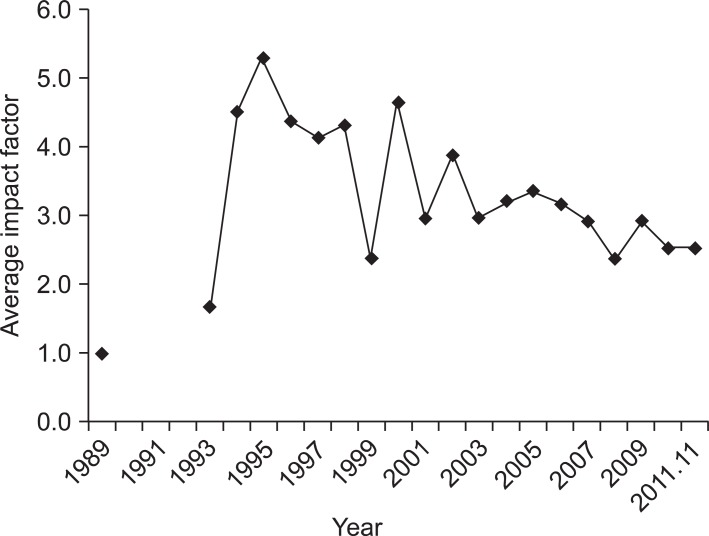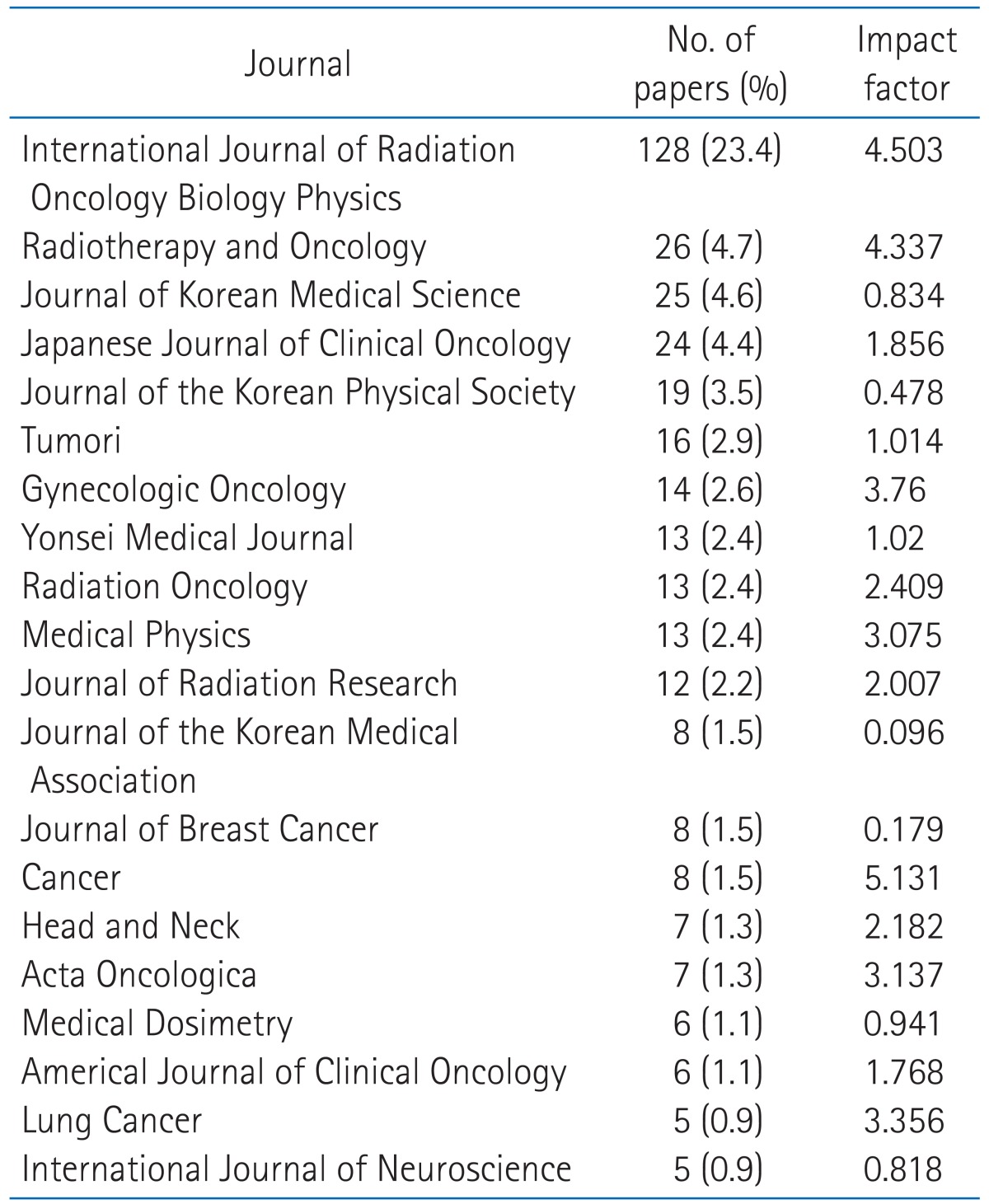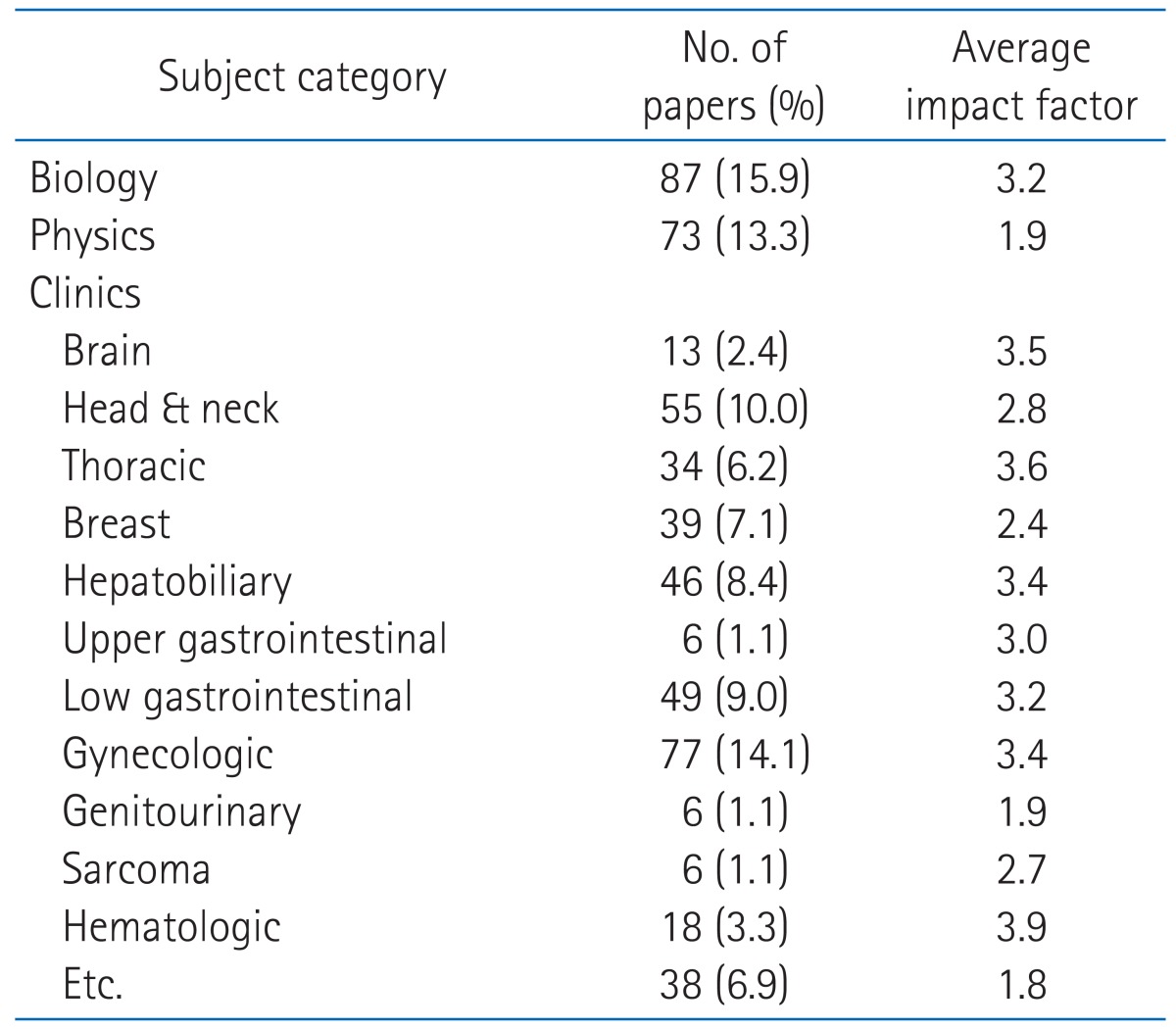Introduction
The total number of Science Citation Index (SCI) papers was 3.2 fold increased from 349,735 in 1974 to 1,108,165 in 2009. The numbers of Korean SCI papers were also rapidly increasing. The proportion of Korean SCI papers increased from 0.0% in 1974 to 3.34% in 2009 [1]. Among those, the papers, especially about various medical science and biological science, have been increasing continuously and occupying 17.6% and 17.1% in 2007, respectively. The cumulative number of papers, in the fields of biomedical research and clinical medicine according to the SCI subject categories until 2009, were 41,695 and 60,711, respectively. Among the subject categories in clinical medicine, the cumulative number of papers in oncology and radiology, nuclear medicine & medical imaging were 5,322 and 5,296, respectively.
In Korea, the number of radiotherapy facilities is growing steadily. In late 2011, seventy-eight facilities have been opened across the country. The numbers of radiation oncologists and physicists are also increasing and the numbers are about 187 and 77, respectively. With the increase in man power and the efforts in the field of radiation oncology, the SCI papers, written by the members of the Korean Society of Radiation Oncology (KOSRO), are increasing continuously.
In this study, we collected the SCI and SCI Expended (SCIE) papers written by the members of KOSRO and analyzed the current status and trend for forward direction.
Materials and Methods
We searched the SCIE database for the period from 1981 to the end of November, 2011 at the site of Web of Knowledge (http://apps.webofknowledge.com; Thomson Reuters). Articles, reviews and proceeding, written by KOSRO members as the first or corresponding authors, were acceptable.
Search terms included the following combinations of subject headings: therapeut radiol, radiat oncol, Korea. For National Cancer Center, combined search terms such as natl canc ctr, Korea and the name of faculties were applied. The date of publication was also included for the search and the impact factor was applied by the 2010 Journal Citation Reports.
Results
Total numbers of SCIE papers written by KOSRO members was 547 from 1981 to November, 2011. Among them, 35 papers are reported by the authors from different institutions. There was no published SCIE paper from 1981 to 1988 and from 1990 to 1992. The title of first SCIE paper was "ESR alanine dosimetry of high-energy electrons in radiotherapy" by Chu S affiliated with Severance Hospital at 1989 in "Applied Radiation and Isotopes." Fig. 1 shows the number of Korean papers and the cumulative impact factors.
The numbers of papers, published in 1995, 2000, 2005, and 2010, increased continuously, which was 2, 14, 40, and 83, respectively. Also, the cumulative impact factors are increasing in proportion to the increasing numbers of SCIE papers. However, interestingly, the average impact factors tend to decrease with years (Fig. 2). The average impact factor was 2.9 for all the published papers during the study period. The highest average impact factor was 5.3 in 1996. The average impact factors were 3.3 and 2.5 in 2005 and 2010, respectively. Three papers, which had published in "Journal of Clinical Oncology" with the highest impact factor of 18.97, were "Angiocentric lymphoma of the head and neck: patterns of systemic failure after radiation treatment" by Kim GE affiliated with Severance Hospital in 2000; "Incidence of BRCA1 and BRCA2 mutations in young Korean breast cancer patients" by Choi DH affiliated with Soonchunghyang University Hospital in 2004; "Low initial human papilloma viral load implicates worse prognosis in patients with uterine cervical cancer treated with radiotherapy" by Kim JY affiliated with National Cancer Center in 2009. The Korean SCIE papers were published in 134 different kinds of journals. One-hundred twenty eight papers were reported in "International Journal of Radiation Oncology Biology Physics (IJROBP)" (Table 1). It occupied 23.4% of all papers. Subsequently, "Radiotherapy and Oncology (RTO)," "Journal of Korean Medical Science," and "Japanese Journal of Clinical Oncology" published 26 (4.7%), 25 (4.6%), and 24 (4.4%) papers, respectively. Table 2 shows the top 10 countries ranked by the number of papers published in IJROBP. United States of America (USA) occupies more than half of the papers. Korea ranked on 9th place in 2007 and came to 7th place in 2011. The percent shares of Korea are increasing from 2.3% in 2007 to 4.4% in 2011.
The numbers and proportions of the papers by subject categories were 87 (15.9%) in biology, 73 (13.3%) in physics, and 387 (70.6%) in clinical studies, respectively (Table 3). The most common subject of clinical studies was gynecology in which 77 papers (14.1%) were published. Head & neck and low gastrointestinal categories were following; 55 (10.0%) and 49 (8.9%) papers, respectively. The average impact factor by subjective categories ranged from 1.8 to 3.9. The highest average impact factor was 3.9 in hematologic subjects.
Among 78 treatment facilities, 45 institutions published at least one SCIE paper. Severance Hospital reported the highest number of SCIE papers. This institution published 91 papers and it took 15.6% of total papers (Table 4). The SCIE papers from the top five institutions, ranked by the number of published papers, occupied 66.3% of the total published papers. Among the top ten institutions, there was a great difference in the proportions of subject categories. According to the percent share of subject categories in each institution, Seoul National University Bundang Hospital is the most common in biology, National Cancer Center in physics and Wonkwang University School of Medicine & Hospital in clinical studies, respectively.
Table 5 showed twenty papers, which were cited more than 40 times. The most commonly cited paper was "Preoperative chemo-radiation using oral capecitabine in locally advanced rectal cancer" by Kim JS affiliated with Chungnam National University Hospital at 2002 in IJROBP which was quoted 112 times. Among those 20 papers, there were two papers in each of biology and physics. The remaining was all about clinical result. Hepatocellular carcinoma was the most common subject, where there were five papers. The institution was Severance Hospital, where the number of highly quoted papers was highest, and seven papers were published.
Discussion and Conclusion
From 2000 to 2009, the total numbers of Korean SCI papers of biomedical research and clinical medicine increased by 2.7 times and 3.2 times, respectively [1]. The number of papers from the KOSRO members, also, increased by 5.7 times. The proportion sharing by radiation oncology, however, was decreased from 8.3% to 7.4% of the papers of Korean oncology categories from the period of 2000-2004 to 2005-2009. The quantitative increase in papers was rapid due to the increase in radiotherapy facilities and man-power such as radiation oncologists and physicists in Korea. However, the average impact factors tend to decrease with years. To publish the papers in good journal, which has high impact factor, is now becoming a parameter ranking the researcher and institutions and competitive challenge.
Most commonly published journal is IJROBP, which takes 23.4%, followed by RTO occupying just 4.7%. In the previous report by Kang [2], IJROBP constituted 31.5% of all the published Korean SCIE papers until 2006. Recently, the kind of reported journals is being diversified. Until 2006, the papers were published in 49 different journals, but now papers are printed in 134 kinds of journals.
Gynecologic oncology consists 14.1% and is the most common clinical category to be published. It makes sense because the gynecological cancer patients were more common in Korea than in western countries. The Head & Neck cancer is not a common category but it takes the second place occupying 10.0%. It might be accomplished by the distinguishing role of radiotherapy, which is combined with or without chemotherapy, for organ preservation.
Kang [2] reported that 81.4% of the SCIE papers were published from the top five institutions and only 19 institutions had experienced the print on SCIE journals until 2006. The number of institutions, however, has increased in 45 institutions. Moreover, the proportion of top five institutions is reduced to 66.3%. National Cancer Center ranks first place among the top five in the number of papers. We think it might be possible that National Cancer Center has good man power, especially, in the field of biology and physics and moreover, unique environment where one can concentrate on the specialized field. The number of citation has increased with time. Until 2006, just five papers (2.8%) were cited more than 30 times [2] but, it increased up to 36 papers (6.6%). All of 20 papers cited more than 40 times had been published before 2005. Half of them were published in IJROBP.
This study has several limitations. First, there might be some missing papers in this analysis which have different search terms to our search terms. Second, the subject categories for each paper were determined subjectively. Some papers might be divided into different categories if it is done by others.
In conclusion, the SCIE papers, in the field of radiation oncology in Korea, are increasing continuously because of the increase in man power and the efforts of KOSRO members. To raise the quality of the papers, multi-institutional studies including retrospective or prospective randomized trials should be taken especially for the common cancers in Korea. For designing, accomplishing and supervising such trials, Korean Radiation Oncology Group and each disease-specific societies of KOSRO should play the pivotal role to enhance the quality of researches in the field of radiation oncology in Korea.





















